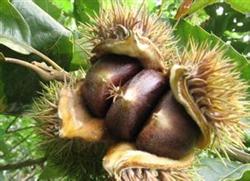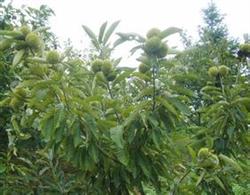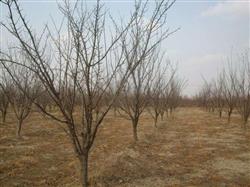Chestnut "empty shell" is well controlled

Chestnut "empty shell" is also called "empty canopy", empty shell rate can reach 30%~90%, affecting chestnut yield. The main reasons for producing empty bract of chestnut are: ① poor pollination and fertilization in flowering stage of chestnut. (2) Boron and available phosphorus deficiency in soil. 3. Influence of other factors. First, varieties, different varieties, different numbers of male and female inflorescences, different consumption of nutrients, empty tent rate is also different. The second is water. In dry years, watering enough water or enough rain in chestnut flowering period, fruit filling period and freezing period can not only make chestnut grow vigorously, but also obviously reduce the empty canopy rate. Third, light, poor illumination, soil moisture, nutrients and oxygen supply shortage, chestnut can not carry out normal photosynthesis and lead to chestnut short shoots, yellow leaves, poor results, empty canopy rate also greatly increased. Fourth, wind, in the flowering period of chestnut, if the wind speed is too large, the empty canopy rate of chestnut increases; if the wind speed is too small, or even no wind, the empty canopy rate of chestnut also increases. The optimum wind force for flowering of chestnut is 3~4, and there is a great difference between open area and non-open area. The control of empty shell of chestnut: ① Select good chestnut varieties with high seed setting rate and low empty canopy rate, such as Jiaozha, Qingzha, Chushuhong, Dahongpao, Jiujiazhong, Maobanhong, etc. 2. Cultivate the best tree structure. From young tree stage to early fruiting stage, it should be planted in moderate density, with natural spindle shape as the best, which can increase early yield and economic income. In the early stage of full fruiting, it should be thinned properly and pruned reasonably to cultivate trunk trees, which can make more effective use of space, increase wind and light conditions of trees, thus reducing empty canopy rate and increasing yield. (3) Pollinating trees should be allocated reasonably. Self-pollinated chestnut has low seed setting rate. Pollinated by multi-pollinated varieties can obviously reduce the rate of empty canopy. It is generally believed that the number of pollinated trees should be 1/3 of that of the main variety trees.④ Proper thinning of male and canopy to reduce nutrient consumption of trees. When the male inflorescence grows to 1~2 cm, it is removed, only 2~3 are left under the mixed inflorescence, so that the ratio of male to female is maintained at 1:149 or more. (5) Artificial pollination. At present, the chestnut orchard with too single variety can be regrafted with some plants as pollination trees. In addition, selecting the varieties with strong affinity, collecting pollen and artificial pollination can increase the seed setting rate by 20%~40%. Strengthen fertilizer and water management to keep trees healthy and grow. Appropriate period topdressing, irrigation, especially in chestnut flower primordium period, pollination period should pay attention to fertilization. For adult trees, urea 2~3 kg or nitrogen and phosphorus compound fertilizer 2 kg can be applied, and irrigation can be applied after application. For mountainous areas without irrigation conditions, in rainy season, the method of making trays under tree crowns and shallow trenches outside the trays is adopted to intercept rainwater and apply green manure in trenches to improve soil fertility. Nitrogen is the main topdressing in the early stage, and nitrogen, phosphorus and potassium should be coordinated in the late stage. 7. Spray boron, phosphorus and other nutrient solutions on leaves. Spraying 0.15%~0.25% boron fertilizer for 23 times at flowering stage could reduce the rate of empty canopy by 23%~32%, and the effect of mixed application with urea and potassium dihydrogen phosphate was the best at full flowering stage. The most effective control period of chestnut canopy was ovule formation (late May) and double fertilization (late June). If potassium dihydrogen phosphate or calcium superphosphate 0.3%~0.5%+ urea 0.3% solution is sprayed for 1~2 times at the initial differentiation stage of female flowers of chestnut, combined with boron, phosphorus and urea spraying at flowering stage, it can not only prevent the empty canopy of chestnut, but also promote the increase of female flowers of chestnut.
- Prev

Post-harvest management of Chinese chestnut
(1) Disease control 1. Dry blight, also known as chestnut blight, chestnut carcass blight, chestnut skin rot, is a fungal disease. Most of the pathogens invade from the wound, mainly harming the trunk and branches, but it is not easy to find at the initial stage. If you scrape the bark lightly with a knife, you can see small reddish-brown spots. After the spots are connected into blocks, the bark surface is raised.
- Next

Pest Control of Apricot cultivation
Apricot wasp: the larva overwinters in the apricot kernel or in the apricot nucleus on the branch, the female adult lays eggs between the nuclear skin and the almond, the spawning hole on the fruit surface is not obvious, slightly grayish green, sunken, sometimes there is apricot gum outflow from the spawning hole, and the egg period is about 10 days. The hatched larvae eat almonds in the nucleus, resulting in a large number of fruit drops. Around the beginning of June.
Related
- Moge, come on! The staff of the peasant association in the producing area of cantaloupe were frightened when the crowd gathered.
- Causes and Solutions of low Fruit setting rate of Apple
- Symptoms and control measures of passion fruit virus disease
- Fruit growing lesson: how do apple orchards keep high yields?
- Can you build orchards in the mountains? What are the pros and cons?
- How to manage the coloring period of Crisson grape?
- This paper introduces the processing technology of two kinds of fig products.
- How much is a month for retired teachers in rural areas by 2020?
- How can strawberry planting increase sugar content? We should pay attention to management in many aspects.
- What are the cultivation techniques on how to improve the yield of golden fruit?

